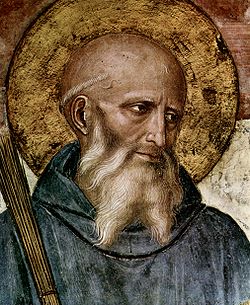St. Benedict
Abbot of Monte Cassino
Biography
Benedict of Nursia (born in Nursia, Italy c. 480 - died c. 547) was a founder of Christian monastic communities and a rule giver for monks living in community. His purpose may be gleaned from his Rule, namely that "Christ... may bring us all together to life eternal" The Roman Catholic Church canonized him in 1220.
Benedict founded twelve communities for monks, the best known of which is his first monastery at Monte Cassino the mountains of southern Italy. There is no evidence that he intended to found also a religious order. The Order of St Benedict is of modern origin and, moreover, not an "order" as commonly understood but merely a confederation of congregations into which the traditionally independent Benedictine abbeys have affiliated themselves for the purpose of representing their mutual interests, without however ceasing any of their autonomy.
Benedict's main achievement is a "Rule" containing precepts for his monks, referred to as the Holy Rule of Saint Benedict. It is heavily influenced by the writings of St John Cassian (ca. 360 - 433, one of the Desert Fathers) and shows strong affinity with the Rule of the Master. But it also has a unique spirit of balance, moderation, reasonableness (epieikeia), and this persuaded most communities founded throughout the Middle Ages, including communities of nuns, to adopt it. As a result the Holy Rule of St Benedict became one of the most influential religious rules in Western Christendom. For this reason Benedict is often called "the founder of western Christian monasticism".

